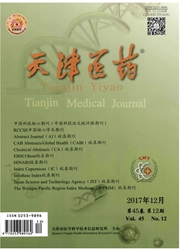

 中文摘要:
中文摘要:
目的:观察人表皮细胞对胰酶消化的耐受能力,通过不同细胞恢复贴壁时间不同来探索分离和纯化表皮细胞的新方法,并探讨胰酶耐受细胞的干性表达,及其与muse细胞的可能相关性。方法:中性蛋白酶及胰酶消化获取表皮细胞,用0.25%的胰酶悬浮表皮细胞,以3.0×105/mL的细胞密度种植于12孔板,每间隔半小时或1小时终止胰酶1孔,其中胰酶作用时间最长达46小时。记录不同细胞贴壁时间、生长状态,并在接种后第7天,对贴壁细胞进行Nestin、Sox10抗体免疫细胞化学染色。结果:随着胰酶作用时间的延长,贴壁细胞数目递减,细胞贴壁所用时间也延长。所有孔中最早出现的贴壁细胞为树突状细胞,这些细胞开始生长缓慢,大约4天后生长迅速,10天后部分孔出现鱼群样细胞团。部分孔经NestinSOXl0抗体的免疫细胞化学染色结果均为阳性,其中以Nestin抗体较明显。结论:人表皮细胞对胰酶消化的耐受能达46小时,从形态学观察判断,黑素细胞贴壁早于角质形成细胞,大多数贴壁后细胞增殖力强,干细胞表面标记显示部分阳性。
 英文摘要:
英文摘要:
Objective: To observe the tolerance of human epidermal cells to trypsinization in vitro. Search for new method of sep- arating and purifying epidermal cells according to the different adherent time, and investigate the tolerant cells express the markers of stern cells, and the correlation with muse cells. Methods: The single epidermal cells were obtained by separating the epidermis from a foreskin, then liberating single ceils from the epidermis. In these procedures, the dispase II and trypsin were used respectively. The ob- tained epidermal cells were resuspended in 0.25% trypsin solution and then seeded in 12-well dishes in density of 3.0x 105 cells/ml. Each well was neutralized by bovine serum at different time points, with an interval after every half an hour or one hour, up to 46 h. To record the time of different cell attachment, and observe the growth state of cells. The adherent cells at 7th day after seeding accepted im- munocytochemical staining with the antibodies ofNestin, Soxl0, respectively. Results: With prolonged trypsinization, the adherent cells decreased, the time to attach to wells prolonged. The earliest adherent cells in all wells were dendritic cells, which proliferated slowly at first, then rapidly after 4 days. At the tenth day, some cells arranged in patterns resembling schools of fish. Some cells showed positive stainings with antibodies ofnestin, sox10, respectively. Conclusions: Human epidermal cells could be tolerant to trypsogen for 46 hours. According to the shape of cells, the earliest adherent cells were melanocytes with strong proliferation ability, other than keratinocytes. Some cells showed positive markers of stem cells.
 同期刊论文项目
同期刊论文项目
 同项目期刊论文
同项目期刊论文
 期刊信息
期刊信息
